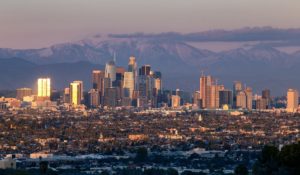To explain his theory of relativity, Albert Einstein pointed out that sitting on a hot stove for five minutes feels like an hour, but sitting next to a pretty girl for an hour feels like five minutes. Los Angeles suffers from the same time dilation. My three years in the city have been more like one extended summer vacation, and any native will tell you that any car trip, no matter how short, invariably takes at least 20 minutes.
The Southern California time warp comes to mind this year, 50 years since the release of “Chinatown,” a neo-noir that survived the years so well that it’s now simply considered noir. Set in 1937 and released in 1974, we are now further along from its release date than the film was from its period piece.
But that’s the odd thing about LA; it’s not just that time moves differently here, it’s that it hardly moves at all. The same evils of the 1930s were echoed in the ’70s and echo still now. If an echo lasts for that long, you may have to wonder if it’s not an echo at all but a deity screaming in your ear.
The protagonist of “Chinatown” is Jake Gittes (a never better Jack Nicholson), a private investigator, who like most of the shamus trade mainly snaps pictures of adulterous spouses. One such woman scorned, a Mrs. Mulwray, tasks him with catching her husband in the act.
Jake knows him by his more respectable reputation, as chief engineer for the Department of Water. You would think he had bigger concerns seeing the city is in a drought, but men always seem to find the time. Time moves differently for them too.
Jake does indeed spy Mulwray visiting a young woman, but also him inspecting several sluices as water spills out. But if there’s water to waste, then why is there a drought? And if there’s no drought, why are the farmers of the San Fernando Valley getting dried out and forced to sell their land?
Then Mulwray is found drowned in a freshwater reservoir with saltwater in his lungs, and then the real Mrs. Mulwray (Catholic convert Faye Dunaway) arrives demanding answers, and I think it’s fair for the film itself to answer them.
This is my third year in Los Angeles, or more technically my third year in the San Fernando Valley. In those three years I’ve learned that depending on the angle of the upturned nose, I may have never been in LA at all. I like the Valley for the same reasons others dismiss it; it’s nice to have a little quiet and an option other than parallel parking.
But that elbow room came at a cost. This is land that once belonged to Native Americans, until they found that Spain came to them. Then it was taken from the Mexicans, who found that America came to them. LA finally came for the farmers, forced out so the city fathers could build swaths of ranch houses, In-N-Out, and a secretly better airport.

I eat the fruits (and burgers) of such evil labors, while perpetuating them for the next generation. Chinatown remains relevant because LA’s original sin is hardly original at all. Locals are still forced out for their land, this time for clout rather than water. We watch helplessly as the fashionable neighborhoods creep east, like a swarm of locusts hungry for cheap rent and leaving behind nothing but stalks and Erewhon grocery stores. Even San Bernardino has begun constructing fortifications for the encroaching hipster caravan.
Though hard to remember during an El Niño winter, I moved down here in a drought (a real drought, with all respect to “Chinatown”). LA already takes most of its water from the Colorado River. When the river ran low on water to borrow, city officials gingerly requested we cut back on our shower times. We, of course, refused with a patriot’s dignity and were bailed out with these last few years of storms. But ask any football team, even the Chargers, if Fullerton won’t return your calls: punting isn’t a solution.
A final lesson from “Chinatown” is that geography molds a people. I am from the Pacific Northwest, a land of beautiful people at icy remove. We take our cue from Mt. Rainier, who looms over us like an emotionally distant mother. My time in LA has made me a bit sunnier in disposition, if no less beautiful.
The characters in “Chinatown” are irrevocably “LA.” The heroes are a desperate sort, unbearably present in the moment because they know there’s no backup plan. When you’re at the terminus of the rail line, you fight back because your back is to the ocean and you can’t drink a drop. The villains are modern conquistadors, forging kingdoms out of the raw material of the desert. Their evil is strong enough to mold the geography, the land withering even further like an Oedipal blight.
If there is an agreement between the two, it’s that LA should not exist. Its continued survival is either an act of ingenuity, hubris, or malice, often all at the same time. For the evil that existentialism is a license to remake the world in their image. For an unlucky few that is a call to purpose, to bring justice to a land without much interest.
On the 405 the other day, just cresting the hills, I saw the graffiti “WE ARE ALL ALONE” spray-painted on the side of a cliff. It couldn’t help but remind me of a line from Nicholson’s character, who when asked if he was alone, quips “Aren’t we all?”
The curse and blessing of Los Angeles is that it just isn’t true. We’re all stuck here together in a land beyond time, loving and killing and sinking deeper as we fight for footing in the muck. Fitting for a city with a tar pit at its heart.

